 |
Until recently, zoologists believed that nocturnally migrating songbirds, while venturing into the unfamiliar night sky during their long trans-continental migrations, could at least relax their vigilance against predators under cover of darkness. A new study by Spanish and Swiss scientists - published this week in PLoS ONE - shows that migration at night is not without predation risk for passerines.
A unique creature can exploit the valuable food source represented by the billions of high-flying Eurasian songbirds on their twice-yearly nocturnal migrations. The danger seems especially acute where birds' flight routes converge around the Mediterranean basin, such as the Iberian peninsula. This newly recognized hazard adds to the numerous obstacles that sea and desert crossings already represent for fragile migratory passerines. The danger comes from the deep black sky, in the form of an aerial-hawking mammal, equipped with a 45-cm wingspan, sharp canines and an efficient radar system that is probably largely inaudible to songbirds.
In 2001, Carlos Ibáñez and his colleagues at the Doñana Biological Station in Seville, Spain, suggested that the giant noctule bat (Nyctalus lasiopterus), a rare European species occurring principally in the Mediterranean, may feed to a large extent on birds (Proceedings of the National Academy of Sciences 98, 9700-9702). They had found numerous feathers in the faeces of Spanish giant noctules, with occurrence peaks in the diet in spring and autumn, i.e. during songbirds' main seasonal migration. This contrasted strikingly with food composition of other European bat species, which all feed exclusively on invertebrates.
This finding created heated controversy among bat scientists. Some claimed that eating feathers was no proof of preying upon birds: they suggested that giant noctules could simply, and accidentally, ingest feathers floating in the air, which are particularly numerous during migration events. According to the sceptics, eating feathers could be a consequence of the bat's echolocation system, which does not allow fine discrimination of targets (such as between insect prey and feathers); also, the costs of swallowing feathers that are casually encountered would be lower than spitting them out (Bontadina and Arlettaz, 2003 Functional Ecology 17, 141-142).
In the case of giant noctule bats, it was the description by Ibañez et al. (2001) of an outstanding predator-prey relationship, previously unrecognized, that triggered so much controversy. Surprising discoveries require indisputable scientific evidence to overcome natural scepticism. Presence of feathers in the diet is not conclusive evidence of a bird-based diet, although it is indicative. Innovative approaches were thus necessary to prove the case. But how to study the foraging habits of an elusive predator that chases its favourite prey several hundreds, if not thousands, of metres above the ground and in total darkness?
To elucidate the mysterious habits of giant noctule bats, an ambitious investigation led by young scientist Ana Popa-Lisseanu, under Prof. Ibañez' supervision, was launched by Spanish research teams based in Sevilla (Doñana Biological Station) and Granada (Zaidín Experimental Station) and funded by the Spanish Environmental Ministry. The programme was soon joined by Prof. Raphaël Arlettaz of the University of Bern and Swiss Ornithological Institute, originally one of the principal sceptics. The technique of stable isotopes was applied because this recently developed method allows species' main dietary specializations and trophic level position along food chains to be tracked.
The researchers concentrated on carbon and nitrogen isotopes, which are among the best dietary tracers. They analysed their concentrations in bats' blood throughout the year, predicting major seasonal shifts in isotopic signatures towards bird prey in spring and, especially, during autumn. In parallel, isotopic signatures of whole insect bodies and passerine muscular tissues were tracked throughout the year, serving as a control. The results elegantly showed that the bats ate only insects in summer, included some songbird flesh in their diet during spring, and depended a great deal on passerines during autumn. Moreover, a higher fraction of songbird flesh in autumn than in spring was attributed to the more massive passerine migration in autumn; both parents and offspring migrate then towards their wintering grounds in Africa, whereas in spring only birds having survived winter mortality return to their breeding area. In addition, young birds in autumn may represent inexperienced, hence more vulnerable, prey.
The ability of giant noctules to prey on the wing upon nocturnally migrating passerines appears unique not only among bats but also within the whole animal kingdom. Although carnivorous bats that feed on small vertebrates are not unknown, they all live in the Tropics and feed on non-flying prey. The few falcon species that capture migratory birds along Mediterranean and African coasts are exclusively diurnal. Owls, typical nocturnal predators, never forage in open space: they listen passively for rustling noises made by terrestrial prey.
The unique ecological niche of the giant noctule may explain some of its peculiar traits. First, the species occurs almost exclusively in certain restricted parts of the Mediterranean where major streams of migrating birds congregate. Second, it is one of the largest Palearctic bats and among the heaviest aerial-hunting bats in the world. A large body mass (up to 50 g for 45 cm wingspan) is probably required to subdue prey items as large as passerines, which weigh about the same as other European bat species.
The extraordinary predatory specialization of the giant noctule may be shared by the few other big aerial-hawking bat species that exist elsewhere in the world. Are some of them similarly stalking unwary songbirds during their massive nocturnal migrations? The foraging habits of these rare bats still remain mysterious, as was the case with giant noctules until recently. Stable isotopes could be a promising tool for unravelling their furtive ecology.
Eurasian songbirds therefore not only have to face the Mediterranean Sea and the immensity of the Saharan desert during their transcontinental journeys at night; a skilled, almost silent, nocturnal hunter patrolling the infinite dark space also awaits them...
To see the full article, click here.

